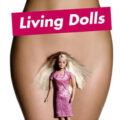Neo-Confessionalism:
Whose Commodity Am I, Anyway?
“We danced until we became markets.” —Bhanu Kapil
 Owning one’s intellectual property, one’s body, and one’s subjectivity may seem like a triumvirate fait accompli for contemporary women writers. Western women in particular. Yet the usurious processes of micro-management, commodification, and market mimesis (shaping one’s self or cultural products to comply with shifting registers of supply and demand) often entail compromises: the hard or soft sell—often without recompense, in the case of, say, contingent academic labor or aesthetic volunteerism—of whatever “products” (immaterial, material, or personal) one can offer the market, or other subjects, to survive.
Owning one’s intellectual property, one’s body, and one’s subjectivity may seem like a triumvirate fait accompli for contemporary women writers. Western women in particular. Yet the usurious processes of micro-management, commodification, and market mimesis (shaping one’s self or cultural products to comply with shifting registers of supply and demand) often entail compromises: the hard or soft sell—often without recompense, in the case of, say, contingent academic labor or aesthetic volunteerism—of whatever “products” (immaterial, material, or personal) one can offer the market, or other subjects, to survive.
Neo-confessionalism, a transgeneric hotbed of addiction and grief memoirs, blogs, tweets, and journalistic exposés, represents the latest in the literary phenomenon of surrendering human capital (one’s putative “interiority” or private life) in a cash market trade-off for “wealth” (cultural capital) and meaning. Giving away one’s literary work online without compensation or engaging in a “tell-all” writing style without reference to the artwork’s frame, if intentional, can be seen as a formalist move (e.g. Tao Lin) or market resistance to the arbitrary assigning of “price” to aesthetic goods. Yet if a neo-confessional writing style and non-remunerative literary endeavors (including publishing, reviewing, and book tours) are undertaken under the compulsion to survive or with the expectation of garnering capital in the literary market, this proffering can equal a form of Sisyphean unpaid labor for those striving for, and not receiving, actual capital: published books, or tenure-track jobs.
Marx spoke about the difference between non-voluntary and voluntary labor in 1844 (important to note that the forced labor he describes, however dehumanizing, was paid): “First, the fact that labor is external to the worker, i.e., it does not belong to his essential being; that in his work, therefore, he does not affirm himself but denies himself, does not feel content but unhappy, does not develop freely his physical and mental energy but mortifies his body and ruins his mind . . . His labor is therefore not voluntary but coerced; it is forced labor . . . External labor, labor in which man alienates himself, is a labor of self-sacrifice, of mortification.” The title of this essay (“Whose Commodity Am I, Anyway?”) alludes to the horror of abjection described by Marx, in which one experiences self-alienation, yet at the hands of a nameless (or, in the case of technoscience, non-human) entity rather than identifiable subject: “Lastly, the external character of labor for the worker appears in the fact that it is not his own, but someone else’s, that it does not belong to him, that in it he belongs, not to himself, but to another.”
Neo-confessionalism has, however, the potential to build community among writers, and remain in productive dialogue with poetry-as-performance and poet-as-personae (Homer, Greek drama, Robert Barrett Browning) and the master artificers of the Confessional School (Sexton, Lowell). The anonymous Anglo-Saxon poets knew the lyric “I” is only ever artifice (“The Wanderer”), as did Milton (“When I consider how my light is spent…”), and Plath (“Lady Lazarus”). All of those poems “seem” intimate, and yet, they use the “I” as a vehicle for impersonality (the very motility of the deictic “I” fueling the sustained illusion).
Neo-confessional exhibitionism collapses the boundary between a staged presentation of interiority conscious of all “I’s” as constructivist and historically mediated, and a style of writing that repudiates all claims to form or that is unconscious of the delineation between form and content and the vested choice of what to reveal, and what to exclude. The legacies of absurdism, surrealism (chance operations, unconscious writing), and “shock art” make it further difficult to parse whether the work is being purposed as “art” (intentioned form) or libidinal catharsis from a post-traumatic subject.
Photography also tends toward Bataillean excess and paroxysm in its recrossing of borders between icon and index, snapshot and time lapse, attenuating the conflict between accident and intention. But, while the common logic is that painters make paintings and photographers take photographs, the photographic image, as Susan Sontag reminds us, always involves conscious intent: “To photograph is to frame, and to frame is to exclude.”
Contemporary examples of art occupying these paradoxical interstices between staged subjectivity, a-semiotic play, and coerced self-exposure to meet labor demands, abounds. From the language experiments of Kathy Acker and Dodie Bellamy to Ariana Reines’ aesthetic of the erotic sublime (whose work B.K. Fischer describes as “neo-confessionalism with theoretical chops”), neo-confessionalism can be seen as a historically-inflected style inherited from literary as well as performative traditions (burlesque, vaudeville) adopted by women to build capital. Its tropes in literary culture today include but aren’t limited to sexuality, gender, addiction, mental illness, and, formally, lyric immediacy, and the co-constituency of reader and author. However, the liberation rhetoric of commodification theory—taking oneself to market as the path to economic parity—only applies when the subject retains private control of her productive capital: freedom through market activities is a tough sell for subjects whose only form of “private property” is their body or powers of self-representation (one recalls Noam Chomsky’s writings on manufactured consent as well as the belief that under conditions of male supremacy the very notion of “consent” is meaningless).
Edward Said wrote that the power to narrate, or to block other narratives from forming and emerging, is a crucial component of culture and imperialism, constituting one of the main connections between them. While barriers to a literary education have been lifted, and more women editors and publishers exist today than ever (VIDA’s 2012 “The Count” providing a timely compilation of gender representation in national periodicals), the problem of women writers and academics not being paid for their endeavors (and taking on monstrous debts to acquire an MFA or Ph.D or promote their work), or being unable to find full-time jobs in academia, enacts the saga of non-remunerative labor as “care work” as in decades past. This unresolved labor issue is the manifest extra-literary symptom of extant gender inequality in literary studies, despite seismic shifts in language use, opportunities for publication, a continued evolution from the historical male representation of woman, and the access women have today to self-representation and textual revisioning (e.g. Alice Walker’s The Color Purple, Margaret Atwood’s Good Bones).
In late capitalism, women’s products and labor are still exchanged between men within heteronormative or homosocial institutions (marriage, family, the workplace). But now the exchange and sale of women’s labor—domestic work, intellectual capital, and, in human and sex trafficking, human beings and body organs—is increasingly done not by men to women, but by women to and among themselves. The market’s newest entrepreneurial capitalists sell exteriorized “privacy” (neo-confessional writing and social media exposure) for cultural capital (publishing credits): or, rarely, finance capital, if one is paid to blog or write experimental memoir, or fortunate enough to find a full-time or tenure-track teaching job.
What part of this process is volitional, and what part is compulsory or survivalist? As Gene Tanta says, what choice does a state-sponsored individual who finds herself in ontological debt have, with no way to “cash out” aside from attempting to sell or give away the “goods?” Socially-engineered or, in the case of Edith Wharton’s Lily Bart, actual, suicide?
The literary culture in which neo-confessionalism takes root is, according to Jacob Silverman, one of market-driven “clubbiness and glad-handing.” Silverman blames literary culture for its myopic insularity: an anemic mix of “cloying niceness and blind enthusiasm.” Criticizing the “BFF” culture among female literary pundits as apolitical, Molly Fischer describes the culture of “ladyblog” publications as winking at rather than subverting convention. Fischer asks whether being “in on the joke” is good enough in a literary culture where there is solidarity only on the basis of a tacitly shared agreement not to critique structural institutions.
Cat Marnell, former beauty editor of XO Jane and Lucky, currently writing for Vice Magazine, has made her reputation by publicizing her struggles with addiction in online interviews and through Twitter (“I’m always on drugs. Look, I couldn’t spend another summer meeting deadlines behind a computer at night when I could be on the rooftop of Le Bain looking for shooting stars and smoking angel dust with my friends and writing a book, which is what I’m doing next”). Marnell’s writing is less about shameless self-promotion than a complete demolition of the Brechtian fourth wall that establishes a new boundary, however provisional, between performer and audience, content and frame. Samuel Beckett’s description of his writing style as “no style” comes close to describing Marnell’s online presence: breezy histrionics that belie her actual struggle with celebrity, addiction, and self. Or do they? Might the New Confessionalism suggest a new aesthetic in which the performer disappears, or the dead author resurrects, in the wake of specular “intimacy” with a virtual population—possibly as an occupational hazard?
Tracie Egan Morrissey drives the point home in her article “Drugs, Blogs, and Cat Marnell: What Happens When One Woman’s Addiction Becomes an Editorial Hallmark?” She suggests that Marnell was, at XO Jane, paid to craft a confessional persona: “After all, the bread and butter of Jane Pratt’s site has been first-person, experienced-based essays, with interoffice activities and conversations between staffers providing fodder for posts that read like reality TV (one source told us that Pratt has been pitching a show about the office).”
Marnell’s choice of what to share (rather than how to share it), of course, remains her own. But Morrisey’s comments elicit the question of whether the neo-confessional mode of total transparency, in addition to flaunting compositional technique by seeming to negate formal concerns, represents a new form of market participation: the self-willed commodification (self-promotion through social media, blogging, and creative writing) of an already-commodified, protean (epigone of capitalism’s flexible, contingent laborer) “self.”
As we progress beyond post-human discourses, fighting reactionary outcroppings of xenophilia, misogyny, animal cruelty, as well as indifference to the suffering of the other (among other ego-, ethno-, phallo-, and logocentrisms of humanism) amid expanding ontologies of human, animal, and corporate subjectivity, one also wonders how, as “consumers” of these performing bodies (in performance art and as bodies of textual work) and these flayed subjectivities, we are complicit.
Cultural complicity is also enacted through women’s economic participation in the cosmetic and weight loss industries (grossing $125 billion in sales last year in the US), furthering the metonymic link between the female reproductive body and capital gain. (Kim Socha: “The augmented woman is the augmented cow is the augmented wood is the augmented sexual identity.”) While sales figures for products or services purchased to maintain societally-enforced standards of beauty or thinness are incontrovertible, the elision of women’s bodies and selves into a smoothly-running market is less easily detected. Carol Adams attributes this discursive and literal invisibility to what she calls the “absent referent” of the female subject in capitalism (the category of woman declared famously by Lacan to be not just absent but ontologically non-existent) in her book The Sexual Politics of Meat. Adams argues, in the book and on her blog, that the humanist discourse of species condones mass killings, product testing, and animal research within a ready-made symbolic economy, wherein the “absent referents” of women and animals are transcoded by the use-value of animals (for eating) and women (as sexual objects), within an overarching logic of domination. As Adams elucidates, if one’s language, experience, or dialect is not legitimized by a logocentric economy (a language comprised, in the case of animals, of onomatopoeic sounds), then this overdetermination takes place seemingly (and disturbingly, amid what Upton Sinclair calls “the hog-squeal of the universe”) without a hitch.
Frederick Engels said, in The Origin of Family, Private Property and the State (1884) that women were the origin of private property: the possession and utility of women’s bodies and subjectivities (as with animal flesh and labor) also belongs to the pleasure-seeking of the ruling class, wherein women and animals are used as instrumentalized tools in the entertainment and circus industries. In “Women on the Market,” Luce Irigaray asks, “Does pleasure, for masculine sexuality, consist in anything other than the appropriation of nature, in the desire to make it (re) produce, and in exchange of its/these products with other members of society?” Derrida refers to the deceptive and corrupt cultural infrastructure of the meat industry called Western Civilization as “carnophallocentrism”: other writers on animal and human capital and the discourse of the brutalized, instrumentalized animal—and female—as occluded other include Martin Heidegger, Emmanuel Levinas, Giorgio Agamben, and Rainer Marie Rilke’s (particularly his 8th Duino Elegy), Agamben speaking poignantly to the pained vulnerability of a wholly externalized subject dominated by sovereign power (a de-politicized constituent’s “bare life”).
Neo-confessionalism is not to be confused with the femme (culture workers Kate Durbinand Meghan Vick’s Gaga Stigmata blog and forthcoming anthology) or the gurlesque movements—though the convergences bear mention, as the latter two movements, while sharing elements of neo-expressionism, have defined praxes of form. Addie Tinnell describes the femme movement thus: “We’re [she and Kate Durbin] interested in femme as a verb, to femme something. In this way, femme at its core seems to be the creation of resonance between people, whether you call that affective labor or intimate solidarity, but it is the production of these deep bonds that are at the root of all decolonial organizing which is our primary interest.”
Arielle Greenberg and Lara Glenum’s Gurlesque: the new grrly, grotesque, burlesque poetics (2010), an anthology of writings from poets such as Brenda Coultas and Cathy Park Hong, borrows liberally from the legacies of the carnivalesque, the burlesque, and the Riot grrl movement of the 90s. If the 60s and 70s encouraged a psychic split in women, sexually and politically, after an era in which their cultural selves were conscribed to domesticity, the gurlesque poet, for Greenberg, likewise “watches herself and is herself at once, both punishing and promoting what she sees, rejecting the notion of herself as object while trying it on for size, parodying femininity through female self-representation that both “incorporates and rejects confession.” Culling the humor, eroticism, and curatorial sense of self from modernist female poets (Mina Loy, Gertrude Stein, Marianne Moore), gurlesque poets, says Glenum, also tap into John Berryman’s externalization of social violence, Frank O’Hara’s deployment of camp, and Amiri Baraka’s positioning of the biological body as the limit of the collective social body.
The 19th and early 20th centuries ushered in a wealth of colonial and post-colonial “outlaw genres”: African American slave and captivity narratives, abolitionist and suffragist personal records, labor activists’ accounts, and oral histories of immigration and exile. These traditions continue today, though increasingly in aesthetic and digitized (cyberactivist) forms. An important schism preceded the technological age’s cleavage between textual and digital forms of self-representation, however: the calling-into-question of the referential “I”. Recent memoirs such as Ayaan Hirsi Ali’s Nomad: From Islam to America: A Personal Journey Through the Clash of Civilizations and Aminatta Forna’s The Devil That Danced on the Water deploy the author’s subject position as embedded in a larger political upheaval, between cultures (Hirsi Ali) or within the author’s country of origin (Sierra Leone, for Forna) as vestiges of testimonial and resistance literature, in which the subject documents through a personal (and undeconstructed) “I” political indictments of oppression and human rights abuse.
The documentarian turn in contemporary poetics and resurgent interest in “truth-telling” in neo-confessional poetries can be traced from New Sincerity to post-conceptual poetics, within a milieu of what Vanessa Place calls a “post-Institutional Critique culture of production.” Uncreative writing paradigms outlined by conceptualist writers such as Kenneth Goldsmith introduced post-identity or “a-poetics”: “My readymade,” says Place, “is also a reverse readymade, and critique proves not so much a matter of contemporary segregation but of an intellectual encounter which may be properly rigorous and properly ahistorical because Kant’s a prioris no longer apply.” The allegories of conceptual poetry descend from post-structuralism (Derrida, Cixous) and the Language School as answers to an unknown question, according to Place, marking our semiotic failure to communicate as the fundamental condition of language itself, and thus the “materiality of poetry” (graphemes, phonemes, morphemes) mere “signage” or placeholders for meaning.
Thus, there is no actual “reading” or “writing” that takes place in conceptual writing, whose texts do not erase but render immaterial all claims to self. According to Place, in her Lana Turner essay “A Poetics of Radical Evil,” this sustained rhetorical gesture is “not concerned with the lack of aesthetic or ethical good, as in insufficient quality/quantity, for that is institutional critique of the dialogic variety, one that hopes that widening the terms of the dialogue will produce more poetic goods—the subjective and objective imperatives will happily coincide.” Accordingly, observes Lindsay Turner in her review of I’ll Drown My Book, an anthology of conceptual writing by women, the female writer’s model is no longer Orpheus (expression) but Echo (repetition).
The empirical data of animals killed per year for human consumption, eco-catastrophe, astronomically grossing cosmetics, plastic surgery, weight loss industries, an inequitable pay scale, and continued public underrepresentation of women, particularly in positions of power, have ceased to shock us. Bee Graham attributes an indifference toward power distortions not to a lack of care, but to “societal Stockholm syndrome,” in which captive subjects learn to be grateful for small tokens of appreciation from an abuser: marrying, volitionally sleeping with, and engaging in ludic play with their kidnapper, or, in Ruth Leys’ trauma theory, mimicking the behavior of the oppressor in order to survive. For Graham, this widespread denial of how the soft and hard labor of women (domestic labor, emotional caregiving, elder and childcare, to aesthetic and public sector labor) whether paid, unpaid or underpaid) continues to subtend capitalism’s commodity cycles is fueled by post-feminism’s disavowals, even while gender-based violence, symbolic and actual, continues as a systemic and global human rights crisis.
The speech, representation, and physical mobility of subjects who have been “subject” to overwriting, censorship, and panoptic surveillance is a matter not just of gender equity, but human evolution. Today it is imperative that women maintain the right to “self-expression” (an anti-conceptualist trope dating back to modernist abstraction as marking class), but also the means for participation in public discourse (if self-censorship or self-recrimination hasn’t been habituated internally). All subjects, too, reserve the right to remain silent, and refuse de jour any Scheherazade-styled “confession” of pathology, misdeed, or pain.
Post-psychoanalytical theorist Eve Sedgwick argues that the embodied male figure in contemporary religious kitsch art is a thematic marker for the potent and devalued categories of kitsch and the sentimental in this century: a figural representation of the “tonally and generically unsettling” first-person mode which activates the range of meanings of sentimentality that identify it not as a thematic subject matter but a structure of relation. Reclaiming and subverting the rhetoric surrounding the moniker “sentimental” (what Lukács called “angst”), once associated with the biological determinism of a female subject’s “I,” has become an important gay male project in progress for close to a century, within and outside of queer politics and aesthetics. Modernity’s dream of aesthetic forms purified from sentimentality represents, for Sedgwick, a modernist association of figuration with prurient vulgarity (a totalized “full meaning” of an artwork or its interpretation), as well as a “full meaning” attributed to any narrative content, which is always, ipso facto, particularized.
The tightrope between self-expression, coerced or compulsory “confession” (the bride of arts and letters stripped bare before her bachelor reading public), and self-erasure constitutes the balancing act of contemporary women’s writing, in images of disappearance and evisceration. From Mary Karr’s Lit: “For the first time in days, inside a rank plastic shower curtain flowering with mildew, water poured over me. And it was in the shower that the acid kicked in — not full bore, just enough to keep me holding myself very still. The suds swirled down my torso like chrysanthemums in a Japanese wood-block print. And my body seemed to smoke.”
If contemporary women writers find it difficult, if not impossible, to write the self, false consciousness (what Louis Simpson called, reductively, in a review of Gwendolyn Brooks’ 1963 Selected Poems, “double consciousness”), or personal history, so as to gain the necessary contextual perspective to be able to structurally critique the larger economic and cultural systems in which we are implicated except through exhibitionist personae or citation, there is a reason. Said alludes to it in his description of the neo-imperialist and corporate capitalist repression of narratives. This repression renders the possession of self—as a means of creating and assigning value (least of all the value of market parity, representation, and self-expression)—inconsequent.
Baring all to strangers, or declining market participation, are both annihilating gestures: the former risks leaving nothing behind but a dissolving wake of short-lived internet celebrity; the latter risks anonymity and silence. However spurred by an anti-utopic conceptual lyric, by a desire to not leave a carbon footprint on the aporetic mirage of postmodernity simulacra, or by a reluctance to speak if speaking means repeating oneself, a valuation of one’s primary audience (oneself) and one’s particularized desires, history, and subjectivity marks the Derridean trace of the life-instinct. The will to representation (Lacan’s “invocatory drive”)—enacted not at the expense of but in recognition of the other—in an aesthetic that is not cauterized from “content” and “consequence”—is the art of “becoming-subject.” The will not just to survive, but to desire (to live).
About Virginia Konchan
Virginia Konchan is the author of four poetry collections, including Bel Canto (Carnegie Mellon, 2022) and Hallelujah Time (Véhicule Press, 2021), and a short story collection, Anatomical Gift. Coeditor of Marbles on the Floor: How to Assemble a Book of Poems (University of Akron Press, 2023), her work has appeared in The New Yorker, The New Republic, Yale Review, Boston Review, and The Believer.





